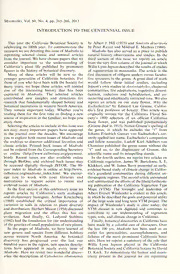Table Of ContentMadrono, Vol. 60, No. 4, pp. 265-266, 2013
INTRODUCTION TO THE CENTENNIAL ISSUE
This year the California Botanical Society is by Albert J. Hill (1973) and Sanicula deserticola
celebrating its 100th year. To commemorate the by Peter Raven and Mildred E. Mathias (1960).
occasionwe aredevotingthisissue ofMadrono to Madrono has also served as a place to publish
reprinting selected classic and seminal articles natural history observations and studies. In the
from thejournal. We have chosen papers that we third section of this issue we reprint an article
consider important to the understanding of from the veryfirstvolume ofthejournal in which
California’s plant life published by prominent Willis Lynn Jepsondescribedtheresultsofstudies
figures in the history ofbotanical discovery. of regeneration in manzanita. The article is the
Many of these articles will be new to the first discussion ofobligate seeders versus faculta-
younger generation of California botanists. For tive sprouters in the genus. A great deal ofwork
those ofyou who have been with the Society for would follow these initial studies, including
many years, we hope these articles will remind Jepson’s own studies in Arctostaphylos chaparral
,
you of the interesting history that has been communities, fire adaptations, vegetative diversi-
captured in Madrono. The selected articles fication, radiation and hybridization, and co-
contributed new insights and directions for occurringandedaphicallyrestrictedtaxa. Wealso
research that fundamentally shaped botany and reprint an article on our state flower, Why the
botanical institutions in western North America. Eschscholtzia? by Edward Lee Greene, Califor-
They remain important today. Whether you’re nia’s first professor of botany. This article was
reading them for the first time or finding a new originally written for the California Floral So-
source ofinspiration in the familiar, we hope you ciety’s 1890 selection of an official California
enjoy them. State flower, and was published posthumously
Selectingthe articles to include in this issuewas (Greenedied in 1915). Notice Greene’s spellingof
not easy; many important papers have appeared the genus, in which he includes the “t” from
in the journal over the decades. We encourage Johann Friedrich Gustav von Eschscholtz’s cor-
you to explore both recent issues ofMadrono and rectly spelled last name. Eschscholtz’s companion
the archives to discover additional favorites and and fellow naturalist, Ludolf Karl Adelbert von
classic articles. Printed back issues of Madrono Chamisso published the genus name without the
can be orderedfrom the Corresponding Secretary “t” and so, to the displeasure of Greene, this
or online (http://www.calbotsoc.org/payment. scientific name and its misspelling stands.
html). Recent issues are also available online In the fourth section, we reprint two articles on
through BioOne, and archived back issues may California vegetation. James W. Bartolome, S. E.
be accessed digitally through JSTOR. The 80- Klukkert, and W. James Barry presented an early,
year index to Madrono is online at http://www. evidence-based study ofclimate change in Califor-
calbotsoc.org/madrono_index.html. We encour- nia’s grassland communities during different an-
age you to work with your libraries and thropogenicregimes. Thesecondarticleannounced
institutions to request access to recent and and summarized the efforts ofthe [then] forthcom-
archived issues of Madrono. ing publication ofthe California Vegetation Type
In the first section ofthis celebratory issue we Maps (VTM). The foresight and leadership of
reprint articles by California’s early ecologists Albert Everett Wieslander is evident in this article,
and evolutionary biologists. Arthur Kruckeberg inwhichhedescribedthegoalsandpotentialutility
VTM
(1969) established the critical importance of ofthe large scale and long term project. The
variation in soils in relation to plant diversity impact of Wieslander’s study is clear today; the
anddistribution. Herbert Mason (1954) discussed VTM dataset is now digitized and continues to
plant migration and the effect this has on contribute to our understanding of vegetation
evolution. And finally, G. Ledyard Stebbins types, soils, and climate change in California.
(1942) laid the foundation for our understanding Finally, botanicaldiscoveriesinCaliforniahave
ofthegeneticsofsmallpopulations ofrareplants. been made by a colorful cast of characters. Over
In the pages of Madrono we have learned of the last 100 yrs, Madrono has been used as an
,
new genera and species from different habitats outlet for personalities, accomplishments, and
across western North America. As botanical failures of the most prominent California bota-
discovery has progressed over the last one nists. Here we reprint a summary ofthe role that
hundred years in the region, new species descrip- Willis Lynn Jepson played in the California
tions have appeared in nearly every issue of Botanical SocietyandCaliforniabotanybyDavid
Madrono. Here we revisit two wonderful discov- D. Keck. To demonstrate the humor and eccen-
eries: the descriptions of Calochortus tiburonensis tricity present in the journal we are reprinting
MADRONO
266 [Vol. 60
what is likely one of the shortest articles ever and it will in this, our California, live long in the
published: Reid Moran’s five-word Noteworthy land.” His words still ring true 75 yrs later. We
Collection. hope this issue will make you laugh, remind you
During his address at the 1938 California ofthe significance ofscientificlegacy ofMadrono,
Botanical Society Banquet, Professor Jepson and inspire your future work on the California
stated, “The future of the Society lies fair and flora. It has been a wonderful 100 years!
bright before it. There is every hope that it will
extend its usefulness to all parts ofCalifornia and Matt Ritter and the Council of the California
that its days will be days ofinspiring growth and Botanical Society
days oftrue felicity. Its friends will be multiplied December, 2013
MADRONO
Thanks to JSTOR for providing scans ofthese historic articles.

